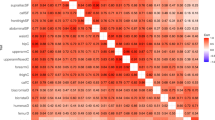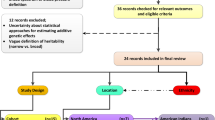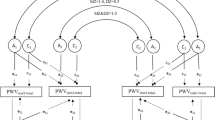Abstract
Objective: (1) To determine by means of multivariate genetic modelling whether the covariation of blood pressure (BP) and body mass index (BMI) is compatible with a direct effect of BMI on BP, or rather with pleiotropy or environmental association, and (2) to quantify the contribution of such an effect and of heritability and environmental factors to BP variance.
Design and methods: Fifty monozygous and 41 dizygous male twin pairs (ages: 17–38 years) were studied. BMI was calculated as weight/height2. Blood pressure was the mean of three conventional measurements in the supine position. Estimates for the path coefficients of the three hypothesised models were obtained using Maximum Likelihood Estimation and were used to calculate the predicted covariance matrices for these models. A χ2 goodness-of-fit index of P > 0.05 indicated an adequate fit. Likelihood ratio χ2 statistics and the Akaike Information Criterion (AIC) were used to choose the best model among the fitting models. The path coefficients of the best model were used to estimate the variance decomposition of BP.
Results: All hypothesised models fitted the data. The AIC was lowest for the model representing an influence of BMI on BP, for both systolic (AIC = −22.3) and diastolic (AIC = −22.2) BP. The estimated percentages of the total phenotypic variance of BP, which could be explained by the influence of BMI on BP, were 11.4% and 12.9% for systolic and diastolic pressure respectively. The remaining variances were associated with variation in genetic and environmental factors.
Conclusions: A direct influence of BMI on BP constitutes the most likely explanation of the BP–BMI-covariation and it accounts for about 12% of the BP-variance in young healthy men.
This is a preview of subscription content, access via your institution
Access options
Subscribe to this journal
Receive 12 digital issues and online access to articles
$119.00 per year
only $9.92 per issue
Buy this article
- Purchase on Springer Link
- Instant access to full article PDF
Prices may be subject to local taxes which are calculated during checkout
Similar content being viewed by others

Author information
Authors and Affiliations
Rights and permissions
About this article
Cite this article
Vinck, W., Vlietinck, R. & Fagard, R. The contribution of genes, environment and of body mass to blood pressure variance in young adult males. J Hum Hypertens 13, 191–197 (1999). https://doi.org/10.1038/sj.jhh.1000784
Received:
Revised:
Accepted:
Published:
Issue Date:
DOI: https://doi.org/10.1038/sj.jhh.1000784
Keywords
This article is cited by
-
Genetic and environmental influences on body fat and blood pressure in African-American adult twins
International Journal of Obesity (2006)


